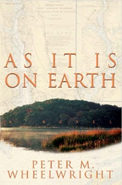Two of my favorite writers on their garden benches, a tree over each of their left shoulder, and their heads tilted slightly rightward…as if they share one of As It Is On Earth‘s character’s poignant tendency “to see the slant of things better that way.”
In AIIOE, I was interested in two aspects of seeing: one literal and the other figurative. In the former sense, I tried to capture our inability to see important aspects of our world without the aid of instruments (at both the cosmic and atomic scales). This is typified by Miryam’s telescopic lens for seeing the stars, and Esther’s microscopic lens for seeing her daughter’s minute red spot.
But, although we generally conduct our affairs in a world that falls in-between and which is available to the naked eye, we still often find that looking right at things does not necessarily reveal their truth; one must look to the margins, to look askew. This from the opening chapter:
“My brother and I know the stars by different names; perhaps that’s what distinguishes us most. Either way…or either one…I wondered if he had really seen that cluster. Even back at the farm in Maine where M42 drifts high in a disturbingly black winter sky, it’s very difficult to see it without binoculars. Nevertheless, Bin told me he found it just before falling asleep. Very low in the sky. On the horizon. He’d had to turn his eyes about 15 degrees away to catch a flickering glimpse. But he was certain of what he’d seen. This is something else new and unusual about my younger brother – his interest in seeing things without looking right at them.“








